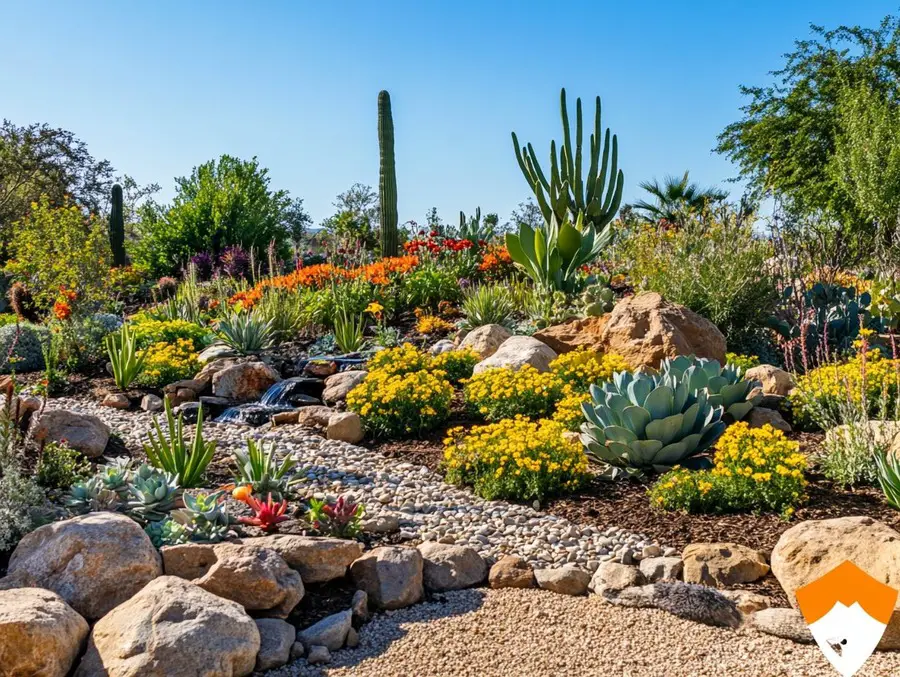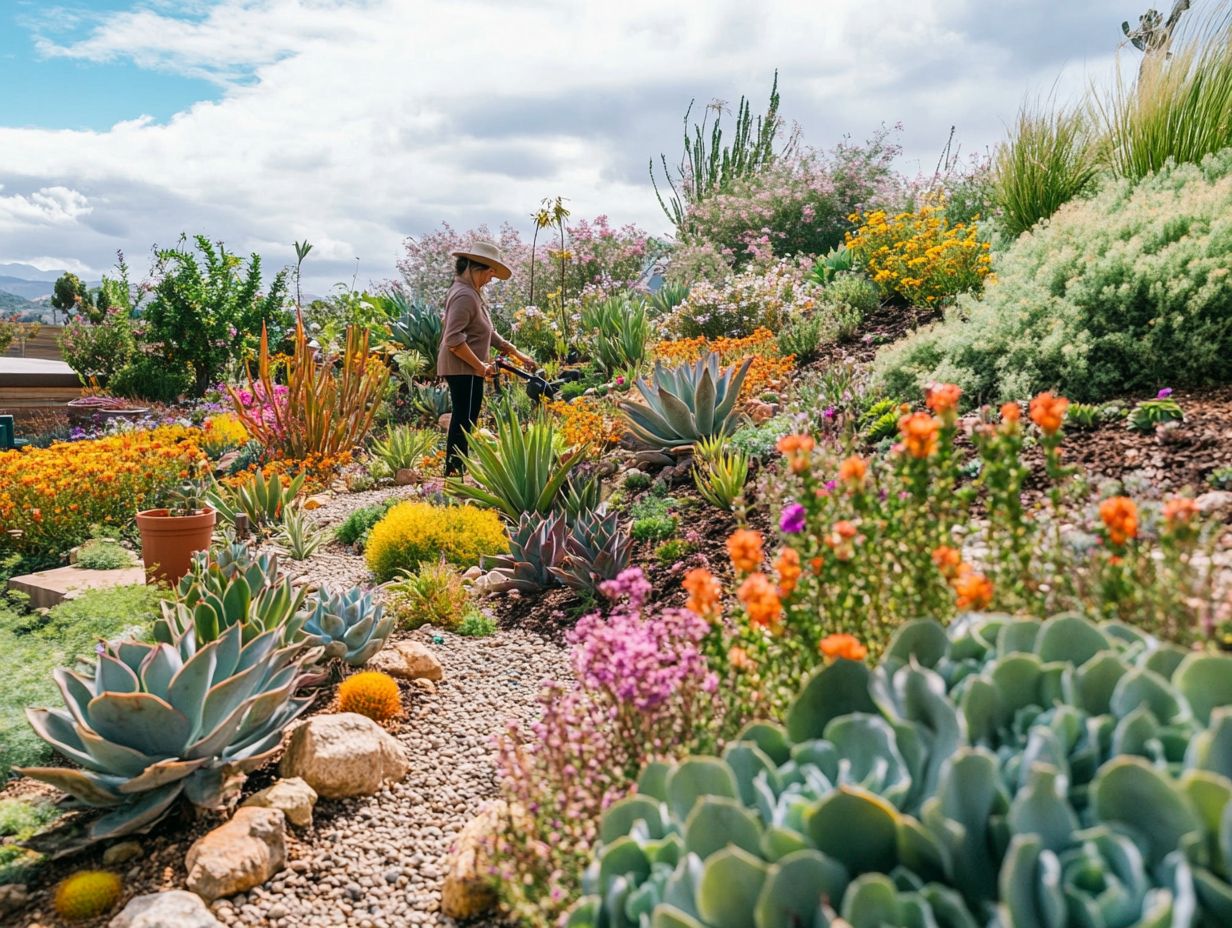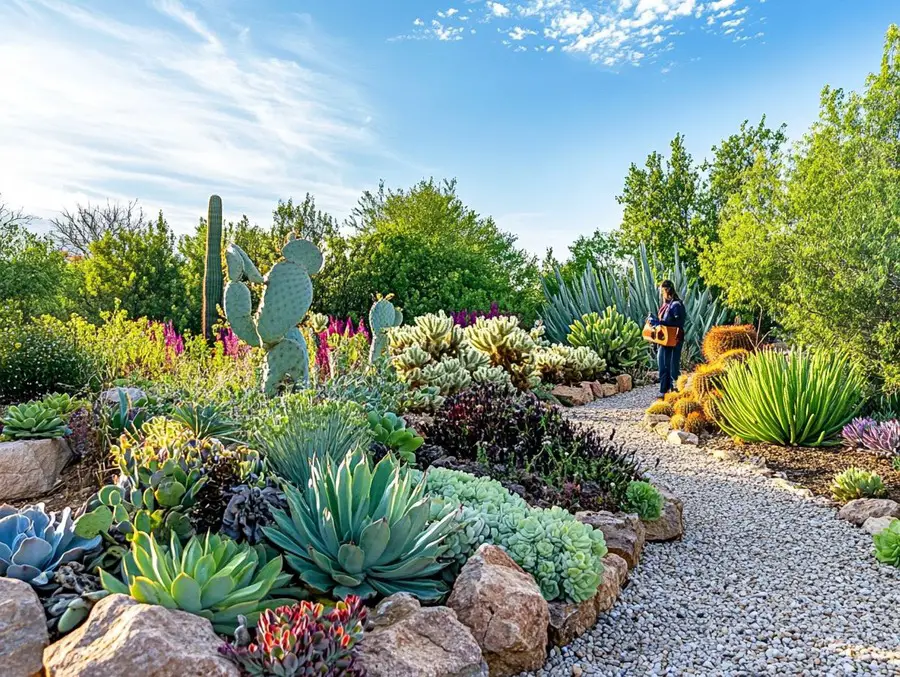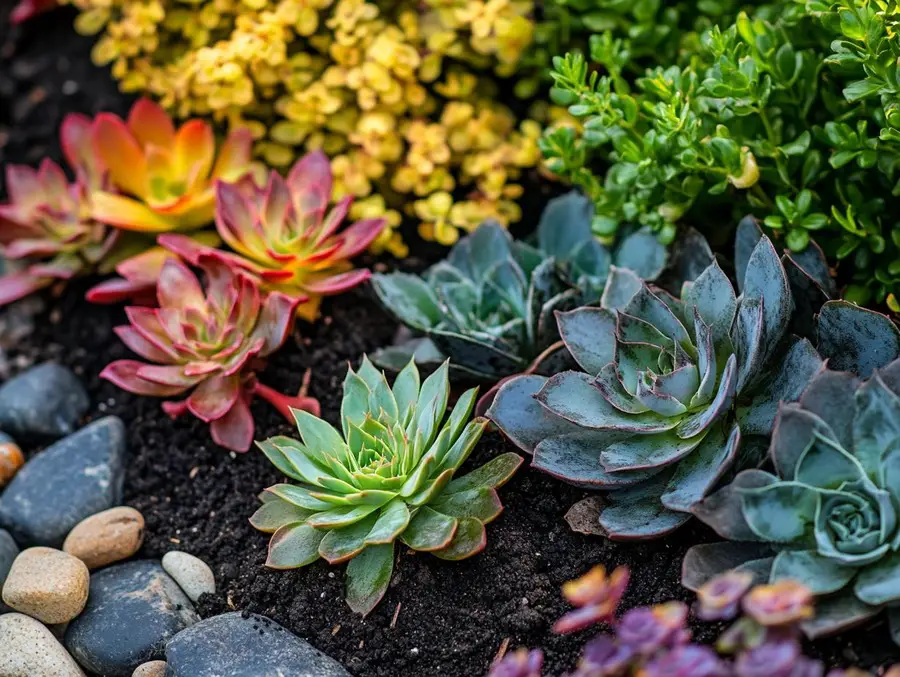We use affiliate links. If you purchase something using one of these links, we may receive compensation or commission.

In a world where sustainable gardening is becoming more important, xeriscaping really shines as an eco-friendly approach that helps you save water while making your outdoor space look great.
In this article, you’ll dive into the concept of xeriscaping, learning what it is and all the benefits it brings.
You’ll discover how to pick the right edible plants, from herbs to fruits and vegetables, that can really thrive in this efficient landscape.
With practical design tips, maintenance advice, and pest control strategies, you’ll be set to create a flourishing, edible oasis in your xeriscaped garden.
What is Xeriscaping?
Xeriscaping is a clever landscaping method that helps you cut down on water usage in dry climates while still creating beautiful and functional outdoor spaces.
By using drought-tolerant plants and native species, xeriscaping conserves water and boosts local ecosystems.
This means you can have vibrant gardens without having to rely heavily on irrigation, which is perfect if you’re environmentally conscious.
Xeriscaping is all about making smart choices when it comes to plant selection and soil amendments to keep your soil healthy and your plants strong.
It even encourages biodiversity by incorporating a mix of plants that thrive in your local environment.
So, you can enjoy a stunning garden that’s kind to the planet!
Definition and Benefits of Xeriscaping
Xeriscaping isn’t just a gardening fad.
It’s a smart, sustainable landscaping solution that really boosts your water conservation efforts while promoting soil health and biodiversity.
This innovative landscaping approach focuses on using native, drought-resistant plants that thrive with minimal watering, which means you can drastically cut down on your water usage.
It lowers your maintenance costs because these tough plants don’t need much fertilizer or pesticide, making it a savvy choice for those who want to keep their budgets in check.
Xeriscaping can adapt to different climates, so it survives and thrives in dry areas, all while adding a beautiful touch to your landscape.
By creating habitats for beneficial wildlife and cutting down on traditional lawn care, xeriscaping plays a key role in supporting sustainable practices and boosting biodiversity.
Choosing Edible Plants for Xeriscaping

Choosing edible plants for your xeriscaping project can be an exciting adventure.
It’s a great way to blend the joys of gardening with sustainable practices.
You get to grow flavorful herbs, vegetables, and fruit-bearing plants all while conserving water. How great is that?
Factors to Consider
When you’re choosing edible plants for xeriscaping, there are a few key factors to keep in mind, like drought tolerance, soil health, and how well the plants will adapt to your local climate.
You should definitely take a close look at the water requirements of the plants you pick to ensure they’ll thrive with minimal irrigation.
It’s also a good idea to think about how compatible they are with native species. Incorporating local plants helps create a more sustainable ecosystem that supports wildlife and beneficial insects.
By fostering biodiversity, you make your garden more resilient and promote sustainable practices that care for the environment.
Choosing plants that provide both food and visual appeal will enhance your landscape, turning it into a productive and beautiful space for you and nature.
Types of Edible Plants Suitable for Xeriscaping
You’ll find a variety of edible plants that thrive in xeriscaping, each bringing its own unique flavors, nutritional benefits, and ability to withstand dry conditions.
These plants are perfect for creating a sustainable garden that’s as practical as it is delicious.
Herbs are Suitable for Xeriscaping

Herbs are a fantastic choice for xeriscaping because many of them are naturally drought-resistant.
They can add a burst of flavor to your dishes while boosting the biodiversity of your garden.
These hardy plants thrive in dry conditions and come with a bunch of health benefits.
Take rosemary, thyme, and sage, for example—they’re known for their ability to handle dry spells, making them perfect for a low-maintenance, water-efficient garden.
In terms of cooking, these herbs can really elevate your dishes, giving them depth and aroma.
They also pack a punch with antioxidants and anti-inflammatory properties.
You can take it a step further by using companion planting strategies.
Pairing drought-tolerant herbs with similar plants can enhance their resilience, keep pests at bay, and promote healthier soil.
By thoughtfully mixing these elements, you can create a thriving xeriscaped garden that’s both functional and pleasing to the eye.
Fruits and Vegetables
Incorporating fruits and vegetables into your xeriscape is a fantastic way to promote sustainable gardening while boosting your food security and encouraging healthier eating habits.
By carefully selecting drought-tolerant varieties, you can contribute to local ecosystems and minimize your water usage.
Think about options like figs, pomegranates, and certain types of squash.
They adapt well to dry conditions and bring unique flavors and nutritional benefits to your table.
These plants usually thrive in well-drained soil and need full sun exposure, making them perfect for your xeriscape designs.
To help these resilient favorites flourish, it’s crucial to provide organic mulch to retain moisture and use efficient watering methods like drip irrigation.
This thoughtful approach to gardening can lead to a sustainable harvest that nourishes you and supports community resilience as we face increasing climate challenges.
Native Plants
Using native plants in your xeriscaping is a brilliant way to boost biodiversity while keeping your garden healthy and resilient in dry conditions.
These plants are like nature’s little champions. They’ve evolved to thrive right where you are, which means they’re super drought-tolerant and easy to care for.
By adding these plants to your garden, you’re not just slashing your water usage.
You’re also creating a cozy habitat for local wildlife, from buzzing bees to fluttering butterflies and all sorts of beneficial insects.
Embracing native flora is a big win for sustainability and helps your garden stand strong against the impacts of climate change.
It plays a crucial role in preserving local ecosystems, maintaining that natural balance of biodiversity, and creating a lively, thriving landscape that everyone in the community can enjoy.
How to Incorporate Edible Plants in Xeriscaping
By incorporating edible plants into your xeriscaping design, you can create a garden that’s visually appealing and productive.
It’s a great way to promote sustainable practices and show a little love for the environment.
Design Tips and Tricks
Crafting a successful xeriscape with edible plants is all about thoughtful design tips and tricks that boost both looks and functionality.
To create a visually appealing layout, think about how you arrange different plant species.
Focus on harmonious color schemes that make your space feel inviting.
When you’re choosing edible plants, consider pairing them strategically.
This maximizes your space and enhances growth through companion planting techniques, which can help keep pests at bay and promote healthier plants.
Adding native plants alongside your edible selections can take things up a notch.
It supports local biodiversity and aligns with sustainable gardening principles.
This approach beautifies your landscape while also providing fresh produce, making your garden both practical and a pleasure to enjoy.
Maintaining Edible Plants in Xeriscaping
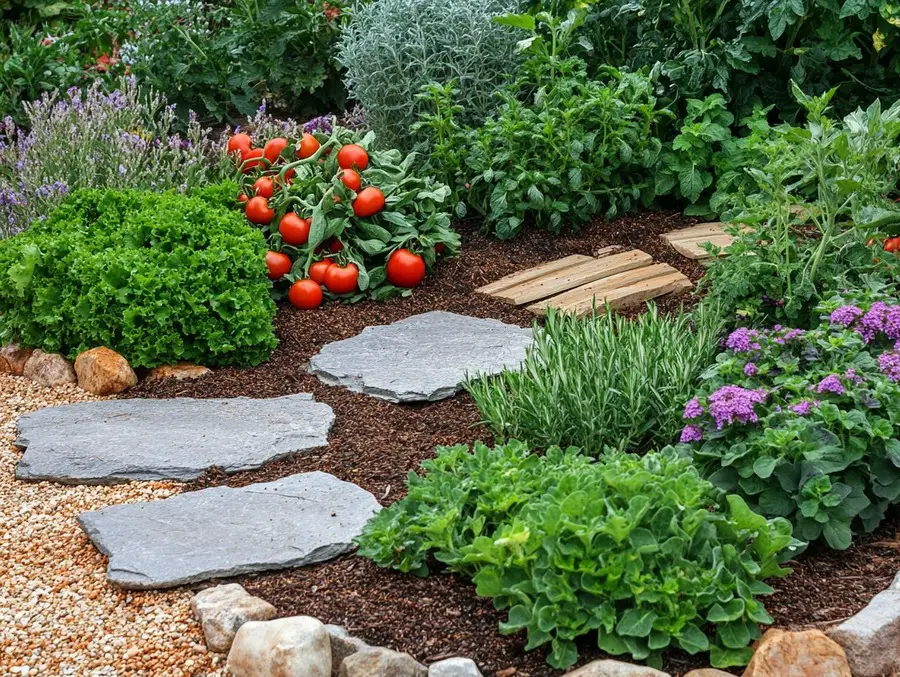
Properly maintaining your edible plants in xeriscaping is key to keeping them healthy, productive, and sustainable, especially in an arid environment.
Watering and Fertilizing Techniques
Adopting effective watering and fertilizing techniques is key to keeping your edible plants thriving in a xeriscape, especially if you’re in a water-scarce area.
Consider implementing a drip irrigation system; it’s a game-changer.
It delivers water straight to the roots of your plants, cutting down on waste and evaporation.
Using organic amendments, like compost, improves the structure of your soil and boosts its ability to hold onto moisture.
Cover cropping can help protect your soil from erosion while enriching it with nutrients.
Don’t forget about mulching with organic materials like straw or wood chips.
This helps regulate soil temperature and keeps moisture in, so you won’t have to water as often.
And if you really want to up your gardening game, think about incorporating sustainable practices like rainwater harvesting.
It’s a smart way to use water efficiently and keep your plants healthy overall.
Pest Control in Xeriscaping
When you’re putting effective pest control strategies into action in your xeriscaping, it’s crucial to protect your edible plants while also promoting biodiversity in your garden.
This balance boosts the overall health of your landscape and helps you rely less on synthetic chemicals, letting you live more harmoniously with nature.
By embracing organic gardening practices, you can try out methods like companion planting, which invites beneficial insects to chase away pests or use natural repellents made from plants.
Incorporating a variety of plant species in your garden can create a resilient ecosystem that attracts pollinators and other helpful critters, ultimately leading you to sustainable pest management solutions that fit right in with xeriscaping principles.
Edible Plants for Xeriscaping FAQs
What is xeriscaping?
Xeriscaping is a type of landscaping that focuses on reducing water usage through the use of drought-resistant plants and efficient irrigation techniques.
What are edible plants?
Edible plants are any type of plant or vegetation that can be safely consumed by humans, either cooked or raw.
These can include fruits, vegetables, herbs, and even some flowers.
Why choose edible plants for xeriscaping?
Choosing edible plants for xeriscaping allows you to have a beautiful and water-efficient garden, but it also provides you with a source of fresh, organic produce that you can eat and enjoy.
What are some examples of edible plants for xeriscaping?
Some popular options for edible plants in xeriscaping include herbs like rosemary and thyme, fruits like strawberries and blueberries, and vegetables like tomatoes and peppers.
Can I still have a diverse and visually appealing garden with edible plants for xeriscaping?
Absolutely! There are many options for edible plants that provide food but also add color, texture, and interest to your garden.
By choosing a variety of plants, you can create a beautiful, diverse space.
Do I need a green thumb to successfully grow edible plants for xeriscaping?
No, you don’t need a green thumb to grow edible plants for xeriscaping.
Many of these plants are low maintenance and easy to grow, making them perfect for beginners or those without a lot of gardening experience.
Best Plants for Xeriscape Gardens: Hardy & Beautiful
Xeriscape Garden Styles: Easy Low-Maintenance Options
Xeriscape Gardening Techniques: Easy Low-Water Tips
Xeriscape Garden Design & Layout: Easy Water-Wise Beauty
What is xeriscaping? A beginner’s guide to drought-tolerant landscaping – Colorado State University
Related Content
Visit my Amazon Influencer Page for videos and gardening products Grow Your Own Garden


